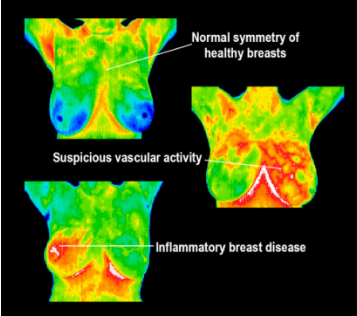Are your Breasts Surviving or Thriving in Today’s Toxic World?
Content by Patricia Lucciardi, our Certified Clinical Thermographic Technician http://patricialuccardi.com/
October is the month that the focuses on Breast Cancer Awareness. Let’s focus instead on breast Health Awareness all year long and ways to prevent cancer at a cellular level and minimize our exposure to environmental toxins.
Endocrine Disruptors
When it comes to breast cancer, the greatest concern is exposure to a group of toxins called endocrine disruptors. These are chemicals and byproducts that mimic the effects of estrogen in the body or cause estrogen to act in a way that isn’t normal. Using these products in combination with hundreds of others chemicals that we regularly come in contact with on a daily basis many increase the risk of several cancers.
The average adult is exposed to 126 chemicals every day just in their personal care products alone. If you want to be healthy, being educated on the latest in toxins is a must! You need to know that your exposures comes from chemicals in household products, personal care, food, plastics, air, water, polyester bras and health care exposures like ionizing radiation.
Plastic & Breast Cancer
The connection between plastic and breast cancer was first discovered in 1987 at Tufts Medical School in Boston by research scientists Dr. Ana Soto and Dr. Carlos Sonnenschein. In the midst of their experiments on cancer cell growth, endocrine-disrupting chemicals leached from plastic test tubes into the researcher’s laboratory experiment, causing a rampant proliferation of breast cancer cells.
Spanish researchers, Fatima and Nicolas Olea, tested metal food cans that were lined with plastic. The cans were also found to be leaching hormone disrupting chemicals in 50% of the cans tested. The levels of contamination were 27 times more than the amount a Stanford team reported was enough to make breast cancer cells proliferate. Reportedly, 85% of the food cans in the United States are lined with plastic. Both of these findings were published in Environmental Health Perspectives. These studies support claims that plastics are simply not good for us.
Prior to 1940, breast cancer was relatively rare; today it affects at least 1 in 11 women.
Now, let’s talk about bras.
Polyester fabric is soft, smooth, supple – yet still a plastic. It contributes to our body burden in ways that we are just beginning to understand. Polyester is highly flammable. It is often treated with a flame retardant, increasing the toxic load. So if you think that you’ve lived this long being exposed to these chemicals and haven’t had a problem, remember that the human body can only withstand so much toxic load – and that the endocrine disrupting chemicals which don’t seem to bother you may be affecting you years down the road.
Prevention with Thermography
A healthy lifestyle and minimizing your exposure to toxins can help protect your breasts and lower your risk. Experts sat early-detection methods are key. Did you know that thermography is the earliest and most effective way of detecting early breast cancer without radiation? Thermography identifies the levels of these environmental contaminants known as xeno-estrogens and Bisphenol-A that attach to the receptor sites of breasts and mimics our natural estrogens. This is an alarming and increasing common pattern seen in thermographic screenings.
These estrogens affect breast tissue with distinct heat patterns that can be seen on thermal imaging. The textbook appearance is one of “leopard spots” or hypervascularization. You need to know the health of your breast and only thermography can provide you with a visual image and assesses the severity of this syndrome. It can be used as a preventative adjunctive screening for identifying signs of abnormal pathology years before a mammogram. It is safe, environmentally green, radiation -free and safe for pregnant or nursing mothers, young dense breasts, fibrocystic breasts and implants.
Get to know the chemicals that have been linked to breast cancer and take action to reduce your risk. Become an informed consumer. Look around your environment. Read product labels and don’t purchase a product that could harm you or your family. Work with a holistic healthcare practitioner to detoxify your body burden. Evaluate and monitor your breast health on a cellular level with a thermographic screening. Living in a sea of toxins is not to be ignored. Practice radical self-care.
Ask about our next Thermography Screening day.
https://www.niwcenterofhope.org/contact/

